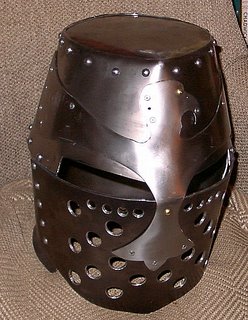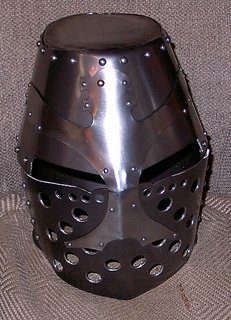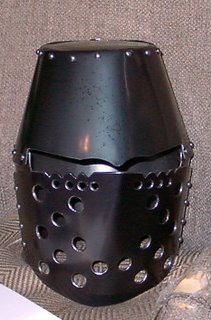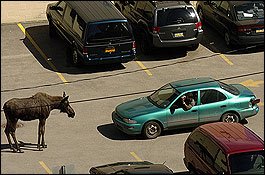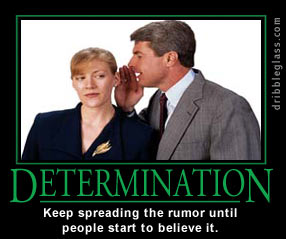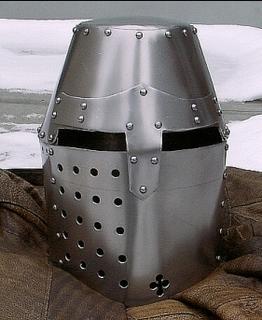This cut and paste was pulled from Mr. Dresner's history forum. Here is the URL. I felt that Mr. Dresner would not object to this publication providing that I not only credit him full, but publish it its entirety. Is a bit long. Might I suggest that you check out Mr. Dresner's forum for yourself, and read the comments. Some of the comments are even longer. Its great fun!
http://hnn.us/articles/2746.htmlHow True to History is Tom Cruise's The Last Samurai?
By Jonathan Dresner
Mr. Dresner is Assistant Professor of East Asian History at the University of Hawai'i at Hilo. His research examines Meiji-era (1868-1912) social history. And he is a member of the HNN group weblog
Cliopatria.
From the opening voiceover and title to the final scene, The Last Samurai is an historical disaster. I expected it to be bad, based on early reviews (e.g. Paul Dunscomb's
social critique and Tom Conlan
on samurai mythology and discussions on
H-Japan). This isn't surprising, of course: popular representations of historical circumstances are often badly done. But this is distinctively and truly awful. There was real drama and adventure in late nineteenth century Japan that could have been even more powerful, but instead we get a pastiche of Dances With Wolves , Karate Kid , Kagemusha and Shogun .
A quick summary of the movie for those who haven't seen it. Yes, I'm going to give away the ending, but if suspense is what interests you, this is the wrong movie anyway: there is almost nothing about the plot or characters that is surprising or original. In 1876, Nathan Algren (Tom Cruise), a PTSD victim who was once a U.S. cavalry captain under Custer, is hired by Japanese industrialist/politician Ōmura (noted actor/director Masato Harada) to train Japanese military conscripts for combat against a gathering storm of rebellion by "the samurai" who do not wish to modernize their ways. In an early skirmish he is injured and captured by the rebels, and recovers in their mountain village encampment over the course of the Fall and Winter when the snows cut them off from the outside. (This begins the Dances With Wolves section.)
As he recovers, he gains remarkable facility with the language -- and the rebel leader Katsumoto (Ken Watanabe) speaks excellent English -- and becomes impressed with the purity and simplicity of the samurai way ( bushidō), not to mention getting really good at Japanese-style armed and unarmed combat (that's the Karate Kid part). Algren joins Katsumoto to lead the rebels against the Imperial forces trained and led by his former commander (Tony Goldwyn, not Custer, but representing the same mindset). Though the rebellion is tactically innovative, the rebels are limited by their adherence to traditional weapons and are obliterated by modern military technology. (Kagemusha, though in that story the leaders were taken by surprise and had the good sense to be horrified at the slaughter of their followers.) Their purity of spirit and devotion to duty nonetheless moves the Japanese Emperor (the Kabuki-trained Shichinosuke Nakamura II), once a student of Katsumoto, to reject a U.S. arms-for-trade treaty brokered by Ōmura. Algren then returns to Katsumoto's village to take up with Katsumoto's sister, Taka (Koyuki), and her children, whom he has converted from hatred (since he killed the man of the house in the course of getting captured) to deep affection with his simple honor. ( Shogun 's romantic plotline was equally implausible, though for different reasons.)
To be fair, some of the background to the story is reasonably true to life. Japan in the 1870s was in the throes of industrialization and radical social and political changes, the process we used to lump together as "modernization." There were samurai who objected to the changes that directly affected themselves, some of whom took up arms in rebellion (more about that below). There was even a plot to assassinate the historical analogue of Katsumoto (though it certainly did not involve a corps of crossbow-wielding ninja). Westerners in 1876 generally considered the Japanese to be an uncivilized people, inferior to Caucasians in culture, intelligence and character. The Japanese government did pay extravagant salaries to foreign experts in fields ranging from history and law to military technology and technique who could teach Japanese to be experts in those fields. Most of those Westerners spent a few years in Japan and then returned to their homelands. Some Westerners, though, became so enamored with Japan that they remained and became quite expert at Japanese culture, even living and dressing in Japanese style. The Meiji Emperor was indeed a young man (about 25 years old in 1876-77) who was largely a puppet of his advisors.
The score will probably get nominated for an Oscar, though its predictable pseudo-exoticism -- wooden flute and twangy strings leavening an otherwise competent musical backdrop -- is a pretty good metaphor for the entire film. The costumes and sets and scenery and military hardware are precise and proper and the swordplay is first rate (aside from some highly implausible sword-throwing). Even the Japanese language material was fine, though the subtitles were idiosyncratic. The consultants (including Mark Schilling, who chronicled his experience in the
Japan Times) did their jobs well enough. And I'm pleased that they showed even a brief snippet of kyogen (comic theater) or a country variation, including participation by the leader Katsumoto. Japan 's deep tradition of humor, including slapstick, sexual and situation humor, is too often lost in the haze of "serious" traditions like Zen and samurai and Nō.
The acting is mostly competent, though there are some standouts. One of the best roles in the film is played by Seizō Fukumoto. Fukumoto is a four-decade veteran of Japan 's samurai and yakuza movies, describing himself as a kirareyaku -- literally, "the actor who gets cut," whose main role is to be killed by the hero in a climactic fight scene. In The Last Samurai he is "The Silent Samurai," whose wordless watchfulness draws Algren's ire and derision, but whose martial skill and valor are undeniable by the end. Though standard Japanese TV samurai dramas are a little less bloody than this film, they feature most of the same good qualities: historical scenery, redemption through honor, and neat swordfighting. When I lived in Japan , my favorite regular hour of TV was Mito Kōmon , the tale of the retired daimyō lord and his samurai retainers who travel the countryside incognito, righting wrongs. I wonder why more of them haven't been made available in the U.S., when there is clearly an audience.
The movie actually gets some of the deeper historical context right, probably accidentally: After a decade of intense social and economic change, the Imperial government in the 1880s began a deliberate program of moral and ethical and historical propaganda, the aim of which was to instill in Japanese a sense of unity centered on the Emperor, particularly on his mythological status as a "living god," a direct descendant of the deities which created Japan. (see, for example, the preamble to the
1889 Constitution) The tropes and themes of this newly constructed nationalism were drawn from Japanese Confucianism, Bushidō and Shinto, with a bit of Prussian constitutionalism for legal structure, and it was transmitted through the most modern institutions of the day: the national education system and the military. This retention and reinvention of tradition led pretty directly to Japan 's imperialist expansion into Asia and the Pacific, so it's a little hard to see the ending of The Last Samurai as a victory for good and right.
Another accidental truth: the Satsuma rebellion, and quite a few of the other samurai rebellions, were rooted in the inability of those samurai to envision duty and honor without status, or to be a part of a nation striving for growth rather than a privileged class with inherent qualities. In this movie attachment to the symbolism of the sword trumps the fulfillment of duty, or common sense. In the real history, a few thousand samurai's belief in their moral superiority as a class, their refusal to relinquish the privilege of offering special service to the nation, and their attachment to the symbols of the past, trumped participation in the political and technological growth of Meiji Japan. But hundreds of thousands of samurai -- the samurai class was about 5 percent of a population of thirty-five million -- transformed their sense of duty and purpose into new forms, serving in national and local governments, working as police, military officers, and teachers, and investing their time and energy and wealth in modern economic development.
What's wrong with this film, then? Well, almost everything else, starting with the basic premises of the plot. Stephen Hunter's
deconstruction of Cruise's Algren character is singularly thorough. Japan did use U.S. surplus military equipment, particularly around the end of the U.S. Civil War (1861-1865), but by the 1870s Japan had settled on other models: the British Navy and the Prussian Army (they had started with the French model, but switched in 1871, though they continued to use French officer instructors for a few years). So it is highly unlikely that the Japanese would have hired an American.
By 1876, the Imperial Army was, indeed, a conscript army, but had a strong core of volunteers, mostly samurai, and a pretty well-defined training program. They were not using primitive muzzle-loading rifles at that point, either. Japanese commoners, who are so inept at the beginning of the film that they literally can't shoot if their lives depend on it, had proven quite adept with military technology in the 1860s, when small mixed samurai-commoner militias with breech-loading and repeating rifles defeated much larger Shogunal forces still heavily reliant on traditional spear, sword and arrow weaponry. Those militias formed the core of the post-Meiji Restoration (as the 1868 transition is usually called) Imperial Army. And Imperial forces had a few adventures in the 1870s, including the Taiwan expedition (1874) and the mission to secure the Kanghwa Treaty in 1876, not to mention suppression of a number of domestic disturbances, including both samurai and cultivator uprisings.
The rebellion led by Katsumoto in the movie is supposed to be a scaled down version of the 1877 Satsuma Rebellion led by SAIGO Takamori. It's a shame that the moviemakers didn't take that more seriously, because the uprising, known in Japanese as the "Southwestern war," was a true crisis. Every resource of the new government was called upon, including its modernized shipping lines, rail transport, police forces (who were reorganized into military units), samurai volunteers, officer trainees, and fiscal reserves (the Matsukata Deflation of the early 1880s was partly necessary because of the excessive costs of putting down the rebellion). The rebels, protesting the loss of the traditional privileges and domainal autonomy, were quite well-armed, having seized several local armories early in the uprising: many of their officers were trained in modern methods, and they led both artillery units and riflemen. The rebels were only outnumbered by two-to-one; there wasn't a long, tense run-up to the conflict, as the movie insists; Saigo Takamori was not the leader at the beginning; and the fight ran constantly from February through September, rather than being a pair of battles separated by winter storms. There were other samurai uprisings in the years leading up to the 1877 Satsuma Rebellion, some of which actually resemble the movie more closely, at least in terms of scale and the ease with which they were suppressed. But none of the others were led by men who had been Imperial advisors, as Saigo had been. After 1877 there were no more samurai uprisings. (For more details on Saigo, see Mark Ravina's biography,
The Last Samurai: The Life and Battles of Saigo Takamori, which is currently selling considerably better than the official movie guide.)
One intriguing element that the film could have exploited but didn't was the analogy between the Native American tribe and the samurai clan. Very different social institutions, of course, but historians of Japan have long recognized that the failure of samurai rebels to ally across clan lines in the Meiji era (1868-1912) doomed them to failure against the increasingly coherent national polity. Domainal loyalties plagued Japanese politics and military affairs well into the twentieth century. But the movie clearly can't differentiate between the individual samurai clan and the samurai class. The vast majority of Japan 's ruling elites, the modernizers who are so thoroughly evil in the film, were also samurai (many of them from Satsuma), who made the decision to eliminate their own aristocratic privileges. The vast majority of samurai did not protest, did not rebel, and were rather relieved to be freed from the samurai restriction on earning an honest living to supplement their increasingly meager official stipends.
The most blazingly bad bit of history has to do with the arms-for-trade treaty, and I'm surprised that more commentators haven't noted this. The U.S. didn't need to parlay its military technology for trade advantages in Japan . From 1858 to 1899, U.S. trade with Japan was governed by the 1858 Japan-U.S. Treaty of Amity and Commerce, sometimes known as the Harris Treaty after U.S. ambassador Townsend Harris (played by John Wayne in The Barbarian and the Geisha ). That agreement fixed Japan's import duties at a very low level, established the right of Americans to practice their religions freely and to be tried in non-Japanese courts for crimes committed in Japan, and is considered the first of the "unequal treaties" that clearly established Japan as an inferior nation to the Western powers. The Most Favored Nation clause in the earlier Kanagawa Treaty (1854) meant that this was just a starting place: the U.S. would get every advantage negotiated by any other country with Japan . The Japanese were not in any position to make demands or set conditions in their foreign affairs: they spent three decades proving to the Western powers that they were a "civilized" nation that deserved more equal treatment. U.S. diplomatic treatment of Japan was heavy-handed and unpleasant, but it wasn't tawdry in a grovelling, money-grubbing way; it's bad enough, I guess, that the only American with any depth is the one turning samurai (the other respectable caucasians are British and Irish), but there's no need to pile on indignities.
There are a few minor points which I can't just let slip by:
The title of the movie is The Last Samurai but the Japanese ideograph which overlays it just says "samurai."
The opening voiceover refers to the creation of the Japanese islands by a divine sword, which was dipped into the ocean and dripped foam, but every version I've ever seen of Japan's founding myths describes the creation of a single island by foam dripping off of a spear, with the rest of the islands birthed by the gods. Swords don't come up until later.
The Meiji Emperor didn't speak English, and nobody outside of the most senior advisors saw him without an invitation. And he certainly didn't make important political decisions on the spur of the moment.
The Ōmura industrialist/politician character is difficult to pin down historically. He might be an amalgam of political heavyweight ŌKUBO Toshimichi, the younger but more radical and economically connected ŌKUMA Shigenobu, with some of the Mitsubishi founder IWASAKI Yatarō thrown in. Industrialists did not have the Emperor's ear (they didn't need it, having close ties to the samurai oligarchs) and Imperial advisors did not jaunt off to other countries to conduct job interviews.
Most samurai lived in large urban areas, though low-ranking Satsuma samurai were some of the few who lived in the country and also farmed. Even then, nobody lived in the mountains if they could avoid it.
The method of "no mind" is not "The Force" -- simply a matter of clearing one's mind of distractions and then the right thing will happen. It is a Daoist concept, originally, which became part of the martial arts tradition in China , then in Japan and elsewhere. It is a function of training constantly (certainly over more than four months) so that one can react instinctively, automatically, to a rapidly developing situation. Effortlessness comes after lots of hard work. The Karate Kid got that part right, actually.
The notion that the samurai have been "protectors of the nation" for nine hundred or a thousand years (and Katsumoto uses both figures) is absurd: the samurai began as rent collectors and estate protectors for the Kyoto nobility, and evolved into an aristocracy in their own right. Only against the Mongols (1274, 1281) can they be considered protectors of Japan ; it's highly unlikely that Katsumoto's clan was in one place that entire time; very few samurai clans survived the century-long civil war (15-16c) and most of those were relocated in the late 1500s. The Shimazu family which ruled Satsuma did originate in the 11th or 12th century, but Saigo Takamori wasn't a Shimazu. Like most samurai, his family attained warrior status in the 1500s and were unremarkable low-ranking retainers until Saigo.
Taka, attempting to refuse Algren's help with housework, says that "Japanese men don't do that." But many Japanese men did a great deal around the house, just not samurai. The Japanese very rarely referred to themselves as a collective, particularly on cultural matters, as early as 1876-77.
When they eat, they are consistently shown eating fluffy white rice, but only the wealthiest Japanese ate that regularly, and certainly rural samurai would have been more likely to eat rice gruel and other grains like barley and millet and buckwheat, either as gruel or as noodles, that grow better in upland conditions. And the movie glosses over Algren's introduction to chopsticks, which is not an insignificant event in acculturation.
By 1877, very few Japanese would have been particularly frightened of samurai, even samurai as backwards as Katsumoto's band, nor would they have bowed en masse. Urban Japanese had gotten over treating common samurai like daimyo lords a long time before.
Even allowing for Algren's remarkable immersion in Japanese language and culture, the likelihood is pretty small that he'd have run across the Japanese term for "President" in a rural samurai village, but that doesn't stop him from understanding the term when it comes up in a crisis.
Algren's first experience with armor on the day of the climactic battle is pretty implausible. Even allowing for superior physical conditioning and excellent training and the fact that Japanese armor is light and flexible relative to its Western analogues, there's almost no way he wears it as comfortably as he is shown.
The samurai warrior-cherry blossom (sakura) motif is so clichéd that I was surprised that it came up at all, and nearly laughed out loud when it came back just in time for Katsumoto's death. Judging by color, the blossoms were plum, not cherry.
Does it matter? Perhaps not. Perhaps it's too much to expect that our entertainments have a factual basis. But now I have to deal with the aftermath, with students who will think that all samurai (all five hundred of them, instead of nearly two million) were pure warriors who lived in the mountains, instead of as underemployed urbanite bureaucrats. I have to explain how rare seppuku (ritual suicide, also known as hara-kiri) was, how tenuous the samurai sense of loyalty, how the Japanese did not "Americanize," and I have to hope that my careful deconstruction can make some dent in the technicolor, surroundsound, adrenaline-enhanced images in their minds. The Meiji transformation of Japan is one of the most dramatic social and economic periods in modern history, and it ties directly to some of the most important turning points and processes of the twentieth century and present. But instead, The Last Samurai is another barrier to understanding, a step backwards in our collective education.
Note: Japanese names are traditionally written with the family name first; the movie credits put the family name last and I follow that for the cast members, but for the names of Japanese historical figures I have put the family name first and in all capital letters on first appearance: e.g. SAIGO Takamori.
Related Links
